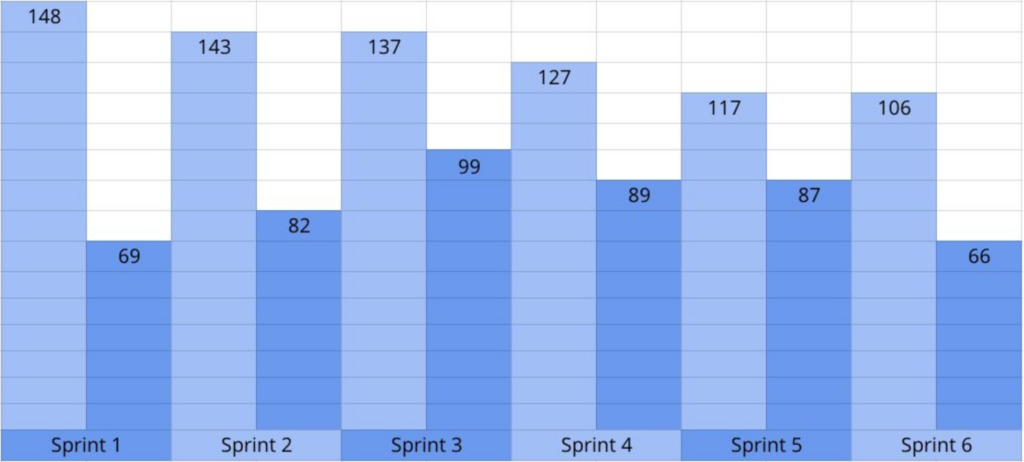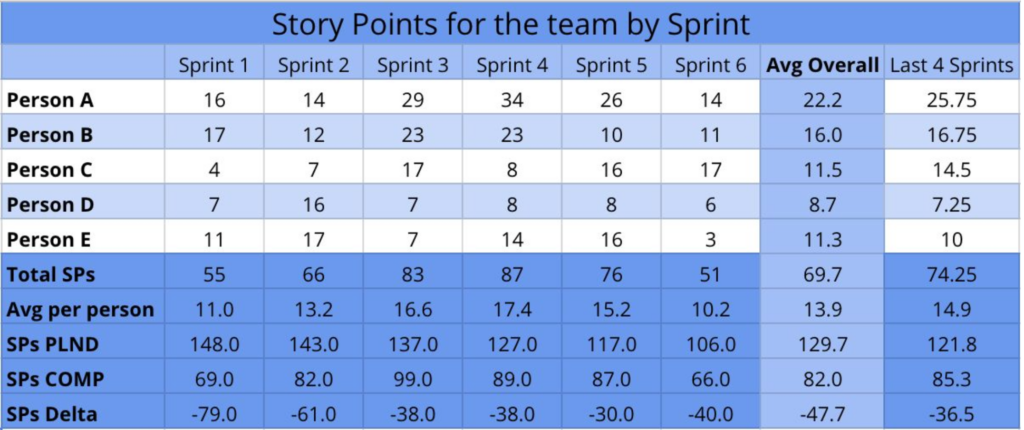Internal Services Processes
By using a combination of project and process management methodologies, groups can improve the quality of communication with their internal customers while decreasing cycle-time and increasing individual and overall throughput.
In Practice
Since 2019, the Production Team has been identifying and grouping their work using an Agile Scrum board. Recently, the team made a concerted effort to identify and estimate their work using the story-points approach, whereby they apply a number (1, 2, 3, 5, 8, or 12) to each individual card on their board. Here are their results over a 6-week period:

The Production Team is comprised of full- and part- time personnel and includes varying roles from Creative Director, Art Director, Video Producer, Scrum Master, and others. The team both originates their work and receives work requests from groups, teams and individuals throughout the organization. They organize and approach these requests as an internal services group. With that, they utilize the Scrum methodology as the best way to go about identifying the work and their available capacity. The team holds a backlog review weekly and sets out the items to be addressed during the week-long sprint.

Looking at the numbers from Sprint 1 in the above grid, the core group (Persons A – E) had a total of 55 completed story points (SPs), with an average of 11 SPs each. Further down, the difference between the planned story points (SPs PLND), 148, and the completed story points (SPs COMP) for the whole team, 69, results in SPs Delta of -79.
The amount of story points on the team’s board at the start of a sprint is getting closer to the amount of completed story points at the end of the 5-day period.
The SPs Delta row shows a downward trend over the 6 sprints. The amount of story points on the team’s board at the start of a sprint is getting closer to the amount of completed story points at the end of the 5-day period. The overall average for the group is -47.7, but when you narrow the focus to the last 4 sprints, that number is still decreasing. This is the aim of the team as a whole.
Focusing on the individual benefits, the row for Person D contains totals averaging 8.7 SPs, with a range of 6 to 16. According to this person’s average overall, ideally they would have no more than 8 – 9 total SPs assigned to them during a given sprint, although they have completed as many as 16 SPs in a recent sprint. Using the below and completed cards, Person D and the group’s Scrum Master could review the type of work completed in Sprint 2 and identify what went well incorporating that type of work into their workload going forward.

Consider the row for Person A. The totals over the 6-week timeframe fluctuate greatly, however, the difference between the overall average and the 4-sprint trend shows an increase in the total cards (read: work) completed. Working with the Scrum Master, Person A could periodically review the group’s backlog and organize cards within each sprint to align with their ideal workload.

The Production Team understands their workload limits better today than they did prior to implementing these methods. They know the conversation, should there be a need for adjusting expectations, is benefited by using data and information to make rational decisions. The group is able to directly engage with the rest of the organization – during the weekly PTW backlog review – to plan, prioritize and set expectations from sprint to sprint.
Summary
As a group or an individual using the above process, knowing what goes in the sprint is ready to be worked on and will be completed by the end of the sprint, provides context for everyone involved. This approach allows people to focus their effort toward a common goal, while improving the quality of communication with coworkers and decreasing cycle-time from ask to delivery.
I would like to thank you for the efforts you have put in writing
this blog. I’m hoping to view the same high-grade content by you
later on as well. In truth, your creative writing abilities has inspired
me to get my own, personal website now 😉
Hi, just wanted to mention, I loved this post. It was practical.
Keep on posting!
Outstanding story there. What occurred after? Good luck!
Hiya, I am really glad I’ve found this information. Nowadays bloggers publish only about gossip and internet stuff and this is really annoying. A good blog with interesting content, this is what I need. Thanks for making this web-site, and I will be visiting again. Do you do newsletters by email?
Thank you for the kind words, Janella. We are working on a newsletter concept, however, our main focus at this time is website content. Your feedback is helpful to us to understand where we should focus our efforts. Thanks!
Thank you for sharing superb informations. Your website is very cool. I’m impressed by the details that you have on this website. It reveals how nicely you perceive this subject. Bookmarked this website page, will come back for extra articles. You, my pal, ROCK! I found simply the info I already searched everywhere and simply couldn’t come across. What a great web-site.
Thank you, Diedre!
As a Newbie, I am always exploring online for articles that can help me. Thank you
Thank you for stopping by and giving a read
Hello, just wanted to mention, I loved this blog post.
Keep up the good work!
Great content! Super high-quality! Keep it up! 🙂
Thank you AffiliateLabz!